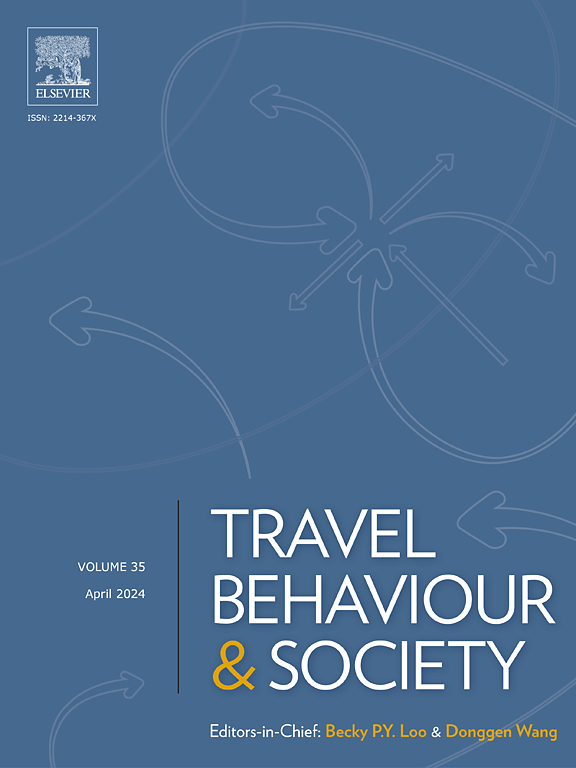利用多式联运加强最后一英里的连接:自选乘客是否青睐地铁城市的自行车出租车公交一体化服务?
IF 5.1
2区 工程技术
Q1 TRANSPORTATION
引用次数: 0
摘要
尽管人们一直在寻求可持续的措施来减少私家车的使用和外部效应,但最后一英里连接不畅仍然是阻碍自选乘车者(车主)考虑使用公共交通的一个主要因素。本研究提出了一个综合自行车出租车-公交车服务(BTBS)系统,作为最后一英里连接问题的解决方案,并调查了自选乘车者对 BTBS 的看法。研究在印度的两个一线城市(班加罗尔)和二线城市(高知)进行,这两个城市的自行车出租车和公交车服务虽然没有整合,但各自独立运营。研究分两个阶段调查了选择骑车者的看法。首先,确定发展综合 BTBS 系统的关键干预领域。其次,建立计量经济学模型,估算自选乘客对 BTBS 系统属性的支付意愿(WTP)以及他们对 BTBS 系统的潜在需求转移。此外,还进行了敏感性分析,以探讨各种属性对需求转移的影响,并确定吸引自选乘客的适当属性水平。在使用修订的重要性满意度分析(修订的 ISA)确定干预区域的同时,还开发了混合 Logit(ML)模型来估算需求和 WTP 值。与以往研究不同的是,干预区域是通过因素结构和管理方案确定的。该研究展示了修订版 ISA 在计量经济学模型属性选择中的应用。这项工作确定了 50%的所列属性为干预区域,而且选择 BTBS 属性的骑行者的 WTP 值明显更高。这表明了 BTBS 的前景,同时也强调了亟需关注的问题。本文章由计算机程序翻译,如有差异,请以英文原文为准。
Augmenting last-mile connectivity with multimodal transport: Do choice riders favor integrated bike taxi-bus service in metro cities?
While the pursuit of sustainable measures to arrest private vehicle usage and externalities continues, poor last-mile connectivity remains a major deterrent for choice riders (car owners) considering the use of public transport. The present study proposes an integrated Bike Taxi-Bus Service (BTBS) system as a solution to last-mile connectivity concerns and investigates the perception of choice riders towards BTBS. The research was carried out in two Indian metro cities, tier 1 (Bangalore) and tier 2 (Kochi), where bike taxi and bus services operate independently, albeit without integration. The study investigates the perception of choice riders in two stages. Firstly, to identify key intervention areas for the development of an integrated BTBS system. Secondly, to develop econometric models for the estimation of choice riders’ Willingness to Pay (WTP) for BTBS attributes and their potential shift in demand towards BTBS. Additionally, a sensitivity analysis was conducted to explore the influence of various attributes on demand shift and to establish appropriate attribute levels to attract choice riders. While intervention areas are identified using Revised Importance Satisfaction Analysis (Revised ISA), Mixed Logit (ML) models are developed to estimate demand and WTP values. Unlike previous studies, intervention areas are identified using factor structure and management schemes. The study demonstrates the application of Revised ISA in attribute selection for econometric modelling. The work identified 50% of the listed attributes as intervention areas and notably higher WTP values of choice riders for BTBS attributes. This indicates the promise of BTBS while emphasizing the need for urgent attention.
求助全文
通过发布文献求助,成功后即可免费获取论文全文。
去求助
来源期刊

Travel Behaviour and Society
TRANSPORTATION-
CiteScore
9.80
自引率
7.70%
发文量
109
期刊介绍:
Travel Behaviour and Society is an interdisciplinary journal publishing high-quality original papers which report leading edge research in theories, methodologies and applications concerning transportation issues and challenges which involve the social and spatial dimensions. In particular, it provides a discussion forum for major research in travel behaviour, transportation infrastructure, transportation and environmental issues, mobility and social sustainability, transportation geographic information systems (TGIS), transportation and quality of life, transportation data collection and analysis, etc.
 求助内容:
求助内容: 应助结果提醒方式:
应助结果提醒方式:


